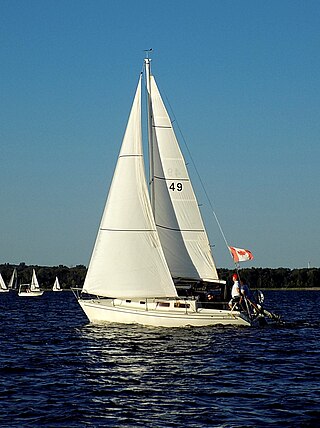Related Research Articles
The Ranger 22 is an American trailerable sailboat designed by Gary Mull as an International Offshore Rule Mini Ton class racer and first built in 1977.
The US Yachts US 25 is an American trailerable sailboat, that was designed by Gary Mull and first built in 1981. The design is out of production.

The O'Day 23 is a series of American trailerable sailboats, that were designed by C. Raymond Hunt Assoc. and first built in 1972.

The Catalina 250 is an American trailerable sailboat, that was designed by the Catalina Design Team and first built in 1995.

The Schock 23 is an American trailerable sailboat, that was designed by Steven Schock, with a wing keel designed by Finnish engineer Reijo Salminen and first built in 1987.
The Santana 30/30 is an American sailboat that was designed by Bruce Nelson and Bruce Marek as a Midget Ocean Racing Club (MORC) racer-cruiser and first built in 1981.
The Sabre 38 is an American sailboat that was designed by Roger Hewson and the Sabre Design Team as a racer-cruiser and first built in 1981.
The Chrysler 22 is an American trailerable sailboat that was designed by Halsey Herreshoff and first built in 1975.
The Elite 25, also called the Feeling 720 NV, is a French trailerable sailboat that was designed by Michel Joubert of Joubert-Nivelt as a cruiser and first built in 1982.
The Ericson 23-2 is an American trailerable sailboat that was designed by Bruce King as a cruiser and first built in 1975.
The Freedom 21 is an American trailerable sailboat that was designed by Gary Hoyt and first built in 1982. It was available as a catboat or sloop rig.
The Newport 214 is an American trailerable sailboat that was designed by Harry R. Sindle as a pocket cruiser and Midget Ocean Racing Club (MORC) racer and first built in 1975.
The Irwin 23 is an American trailerable sailboat that was designed by Ted Irwin as a cruiser and first built in 1968.
The Nimble 25 Arctic, also called just the Nimble 25, is an American trailerable sailboat that was designed by Ted Brewer as a cruiser and first built in 1988.
The O'Day 20 is an American trailerable sailboat that was designed by John Deknatel of C.R. Hunt & Associates as a pocket cruiser and first built in 1973.
The Santana 21 is an American trailerable sailboat that was designed by Seymour Paul as a lightweight racer-cruiser and first built in 1969.
The Santana 23 is a lightweight, 23-foot 4-inch sailboat that was designed by W. Shad Turner and manufactured by W. D. Schock Corp as a "high performance racer" and trailerable cruiser. It was first built in 1978 and remained in production through 1987, with a total of 194 units produced, though the hull was brought back in 1993 as the Santana 2023. It was produced through 1984 as the Santana 23 "D" model, commonly called the Santana 23D, with a retractable, verticle, daggerboard keel similar to racing dinghys, with a remaining 50 produced through 1987 with a traditional keel, called the Santana 23K. The hull was also used to inspire the Wavelength 24 also by Schrock, and supposedly "many other models."
The Santana 25 is an American trailerable sailboat that was designed by W. Shad Turner as an International Offshore Rule Quarter Ton class racer and first built in 1973. The boat was Turner's first design.

The Wavelength 24 is an American trailerable sailboat that was designed by Paul Lindenberg as a Midget Ocean Racing Club (MORC) racer and first built in 1982.
The Starwind 22 is an American trailerable sailboat that was designed by Halsey Herreshoff as a cruiser and first built in 1982.
References
- 1 2 3 4 5 6 7 8 McArthur, Bruce (2021). "Santana 2023A sailboat". sailboatdata.com. Archived from the original on 22 December 2021. Retrieved 21 December 2021.
- 1 2 3 4 5 6 7 McArthur, Bruce (2021). "Santana 2023C sailboat". sailboatdata.com. Archived from the original on 22 December 2021. Retrieved 21 December 2021.
- 1 2 3 4 5 6 7 8 9 10 Henkel, Steve: The Sailor's Book of Small Cruising Sailboats, page 199. International Marine/McGraw-Hill, 2010. ISBN 978-0-07-163652-0
- 1 2 3 Nicholson, Darrell (1 March 1996). "Santana 2023". Practical Sailor. Archived from the original on 21 December 2021. Retrieved 21 December 2021.
- ↑ McArthur, Bruce (2020). "Schock W.D." sailboatdata.com. Archived from the original on 18 July 2020. Retrieved 21 December 2021.